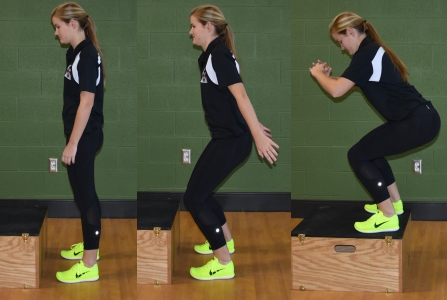Students will discover how to design exercise programs for improving a client’s aerobic and anaerobic capacity. In addition, students will be introduced to the fundamental concepts in movement screening, vocational fitness testing (e.g. police and paramedic), circuit training, and instability training.
Target population: Adults (18-65), healthy
- Course Instructor: Lyndsay Fitzgeorge
- Lab Instructors: Lyndsay Fitzgeorge
- Lab Technician: Jasmine Collins
- Semester: Three
Lab Sections:
- Section 1: Thursday 2 – 4 PM
- Section 2: Thursday 12 – 2 PM
- Section 3: Wednesday 2 – 4 PM
- Section 4: Wednesday 4 – 6 PM
View Lab Exam Feedback
No completed lab exam rubrics currently available
| Course: PHRE 5003 - High Performance Training | Movement Pattern: Lower Body | Target: Quadriceps | Synergist(s): Gastrocnemius, Gluteals, Hamstrings |
| Exercise |  |
| Regressions: | | Progressions: | Depth Jump |
| Key Teaching Points | Expectation: [if 456 equals="Supervised Practice"]Supervised Practice [/if 456][if 456 not_equal="Supervised Practice"]Independent Learning[/if 456] | [579] |
|
| Description: | Box jumps are a plyometric movement designed to improve explosive power, therefore when prescribed should be limited to sets of 6 reps or fewer, with each jump done explosively and with perfect technique.
- Begin with a box of an appropriate height 1-2 feet in front of you. Start with chest up, knees slightly bent and not caving in, athletic position with feet shoulder width apart.
- Perform a short squat in preparation for jumping, swinging your arms behind you.
- Rebound out of this position, extending through the hips, knees, and ankles to jump as high as possible. Swing your arms forward and up.
- Land on the box with the knees bent, absorbing the impact through the legs, landing in the same position as you took off from. You should NOT be landing in a full squat position. You can jump from the box back to the ground, or preferably step down one leg at a time.
Common Errors
- Lifting the knees to almost chest height in order to land on a high box (a sign of great hip mobility (flexion), not jumping power).
- Landing heavy (high stress in shin/ankle).
- Landing with valgus knees (particularly female athletes).
- Rapid fire box jumps involving rebounding off the box (landing in a high stress position for the achilles).
- You see this most often when using box jumps as a conditioning tool (significant injury risk).
- Standing too close to the box and catching the shins on the front of the box.
|
| Common Error(s): | Valgus knees |
| Spotting: | |
>>
Return to My Course Home |

